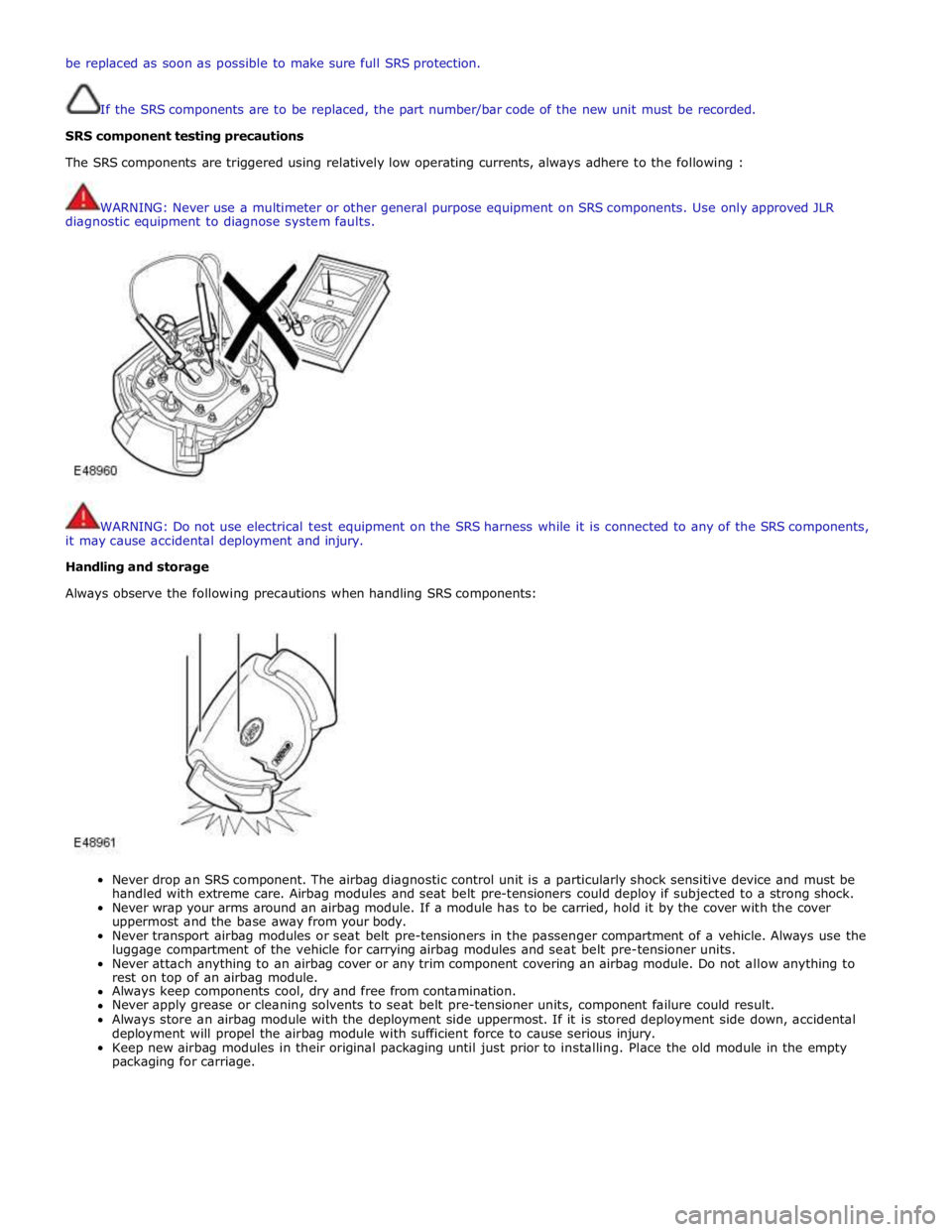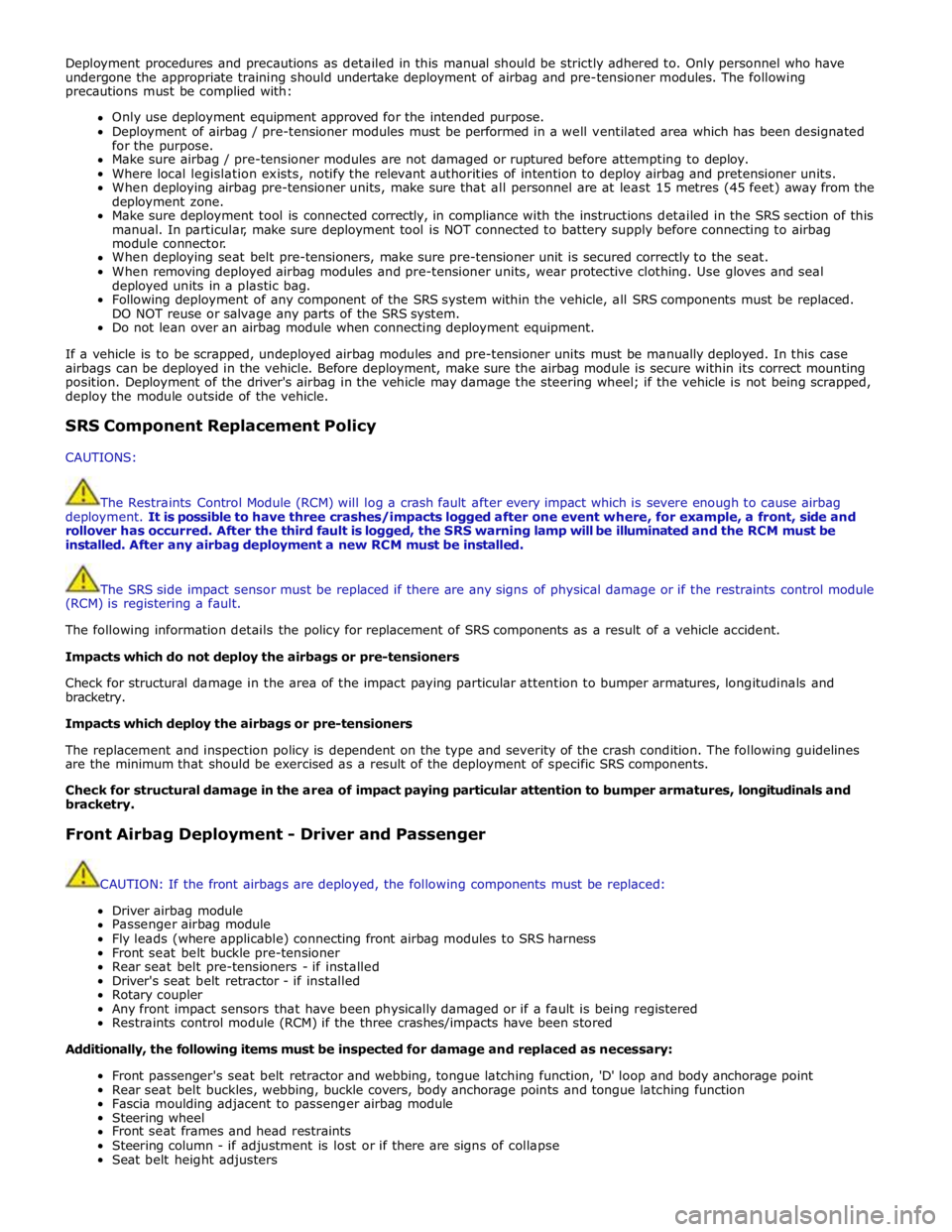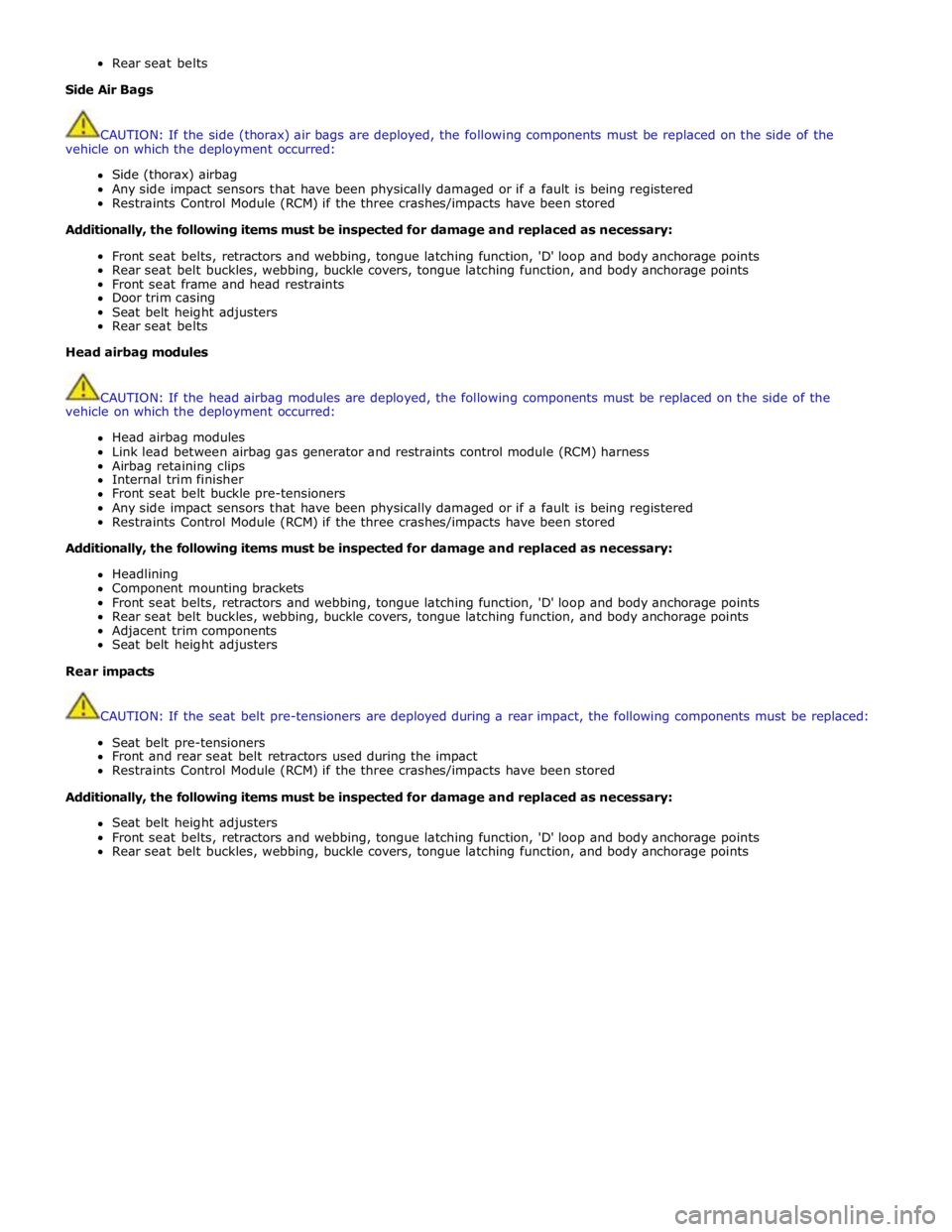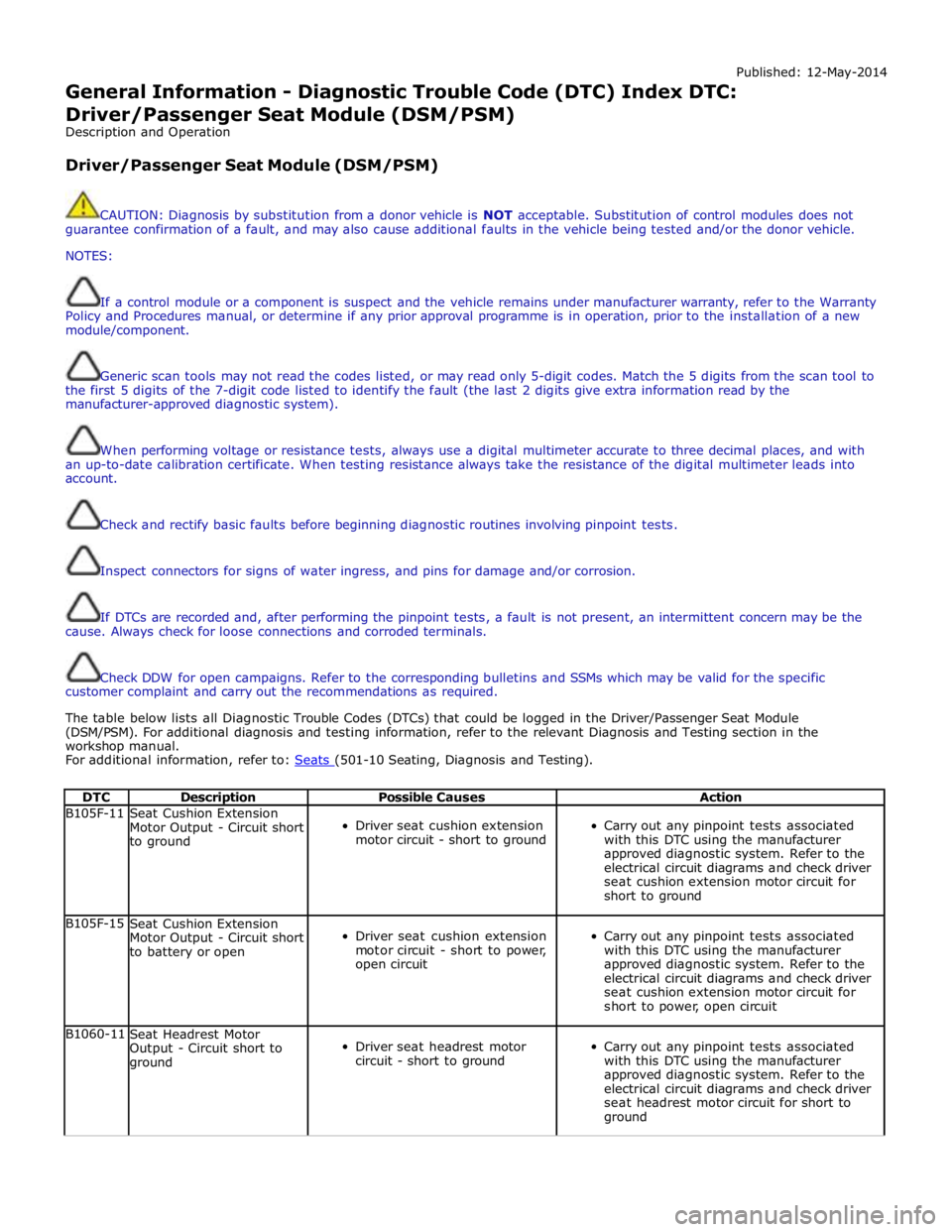seat control module JAGUAR XFR 2010 1.G Workshop Manual
[x] Cancel search | Manufacturer: JAGUAR, Model Year: 2010, Model line: XFR, Model: JAGUAR XFR 2010 1.GPages: 3039, PDF Size: 58.49 MB
Page 2 of 3039

Table of ContentsContents1: General Information
100: Service Information
100-00: General Information
Description and OperationAbout This Manual
Application and Use of Specifications
Battery and Battery Charging Health and Safety Precautions
Brake System Health and Safety Precautions
Diesel Fuel System Health and Safety Precautions
General Service Information
Health and Safety Precautions
How To Use This Manual
Important Safety Instructions
Petrol and Petrol-Ethanol Fuel Systems Health and Safety Precautions
Solvents, Sealants and Adhesives
Standard Workshop Practices
Symbols Glossary
Supplemental Restraint System (SRS) Health and Safety Precautions
Road/Roller Testing
Window Glass Health and Safety Precautions
Diagnostic Trouble Code (DTC) IndexDTC: Adaptive Damping Module (SUMB)
Diagnostic Trouble Code (DTC) IndexDTC: Anti-Lock Braking System (ABS)
Diagnostic Trouble Code (DTC) IndexDTC: Audio Amplifier Module (AAM)
Diagnostic Trouble Code (DTC) IndexDTC: Blind Spot Monitoring System Module (SODL/SODR)
Diagnostic Trouble Code (DTC) IndexDTC: Central Junction Box (CJB)
Diagnostic Trouble Code (DTC) IndexDTC: Climate Control Module (HVAC)
Diagnostic Trouble Code (DTC) IndexDTC: Digital Audio Broadcast Module (DABM)
Diagnostic Trouble Code (DTC) IndexDTC: Driver Door Module/Passenger Door Module (DDM/PDM)
Diagnostic Trouble Code (DTC) IndexDTC: Driver/Passenger Seat Module (DSM/PSM)
Diagnostic Trouble Code (DTC) IndexDTC: Electric Parking Brake (PBM)
Diagnostic Trouble Code (DTC) Index V8 S/C 5.0L Petrol, DTC: Engine Control Module (ECM)
Diagnostic Trouble Code (DTC) IndexDTC: Front Seat Climate Control Module (DCSM)
Diagnostic Trouble Code (DTC) IndexDTC: Headlamp Control Module (HCM)
Diagnostic Trouble Code (DTC) IndexDTC: Instrument Cluster (IPC)
Diagnostic Trouble Code (DTC) IndexDTC: Integrated Audio Module (IAM)
Diagnostic Trouble Code (DTC) IndexDTC: Integrated Control Panel (FCIMB)
Page 53 of 3039

Bus Topology of a
communication
network Coast Clutch Solenoid CCS Camshaft Position CMP Indicates camshaft position Carbon dioxide CO² Colorless gas with a density of approximately 1.5 times that of air Carbon monoxide CO Poisonous gas produced as the result of incomplete combustion Chlorofluorocarbon CFC Catalytic converter
In-line exhaust system device used to reduce the level of engine exhaust
emissions Celsius C
SI term for the Centigrade scale, with freezing point at zero and boiling point at 100 degrees Compact Disc CD Cylinder Head Temperature
Sensor CHT Sensor A sensor for measuring the temperature of the cylinder head Central Junction Box CJB Crankshaft Position CKP Indicates crankshaft position Clutch Pedal Position CPP Indicates clutch pedal position Controller Area Network CAN
A communication system which allows control modules to be linked together Constant Velocity CV Cubic centimeter cm³ Central Security Module CSM Electronic module to support security system functionality Data Link Connector DLC
Connector providing access and/or control of the vehicle information, operating conditions, and diagnostic information Driver Door Module DDM Electronic module to support driver door functionality Driver Seat Module DSM Electronic module to support driver seat functionality Daytime Running Lamps DRL Deutsche Institut fur Normung DIN German standards regulation body Diagnostic Trouble Code DTC
An alpha/numeric identifier for a fault condition identified by the On-Board Diagnostic (OBD) system Direct current dc
Current which flows in one direction only, though it may have appreciable pulsations in its magnitude Domestic Data Bus D2B Digital Versatile Disc DVD Electronic Automatic Temperature Control EATC
Exhaust Gas Recirculation EGR Exhaust Gas Recirculation Temperature Sensor EGRT Sensing EGR function based on temperature change Electronic Brake Force
Distribution EBD
Engine Control Module ECM Electronic module to support engine functionality Electronic Crash Sensor ECS Sensor to measure severity of impact Engine Coolant Temperature ECT Engine Oil Pressure EOP European On-Board Diagnostic EOBD Electronic Pressure Control EPC Electrically Erasable
Programmable Read-Only Memory EEPROM
Erasable Programmable
Read-Only Memory EPROM
Evaporative Emission EVAP
System designed to prevent fuel vapor from escaping into the atmosphere. Typically includes a charcoal filled canister to absorb fuel vapor Flash Electrically Erasable
Programmable Read-Only Memory FEEPROM
Front Electronic Module FEM Flash Erasable Programmable
Read-Only Memory FEPROM
Frequency Modulation FM Fuel Pump Driver Module FPDM Fuel Rail Pressure FRP Generic Electronic Module GEM Ground GND
Electrical conductor used as a common return for an electrical circuit or
circuits, and with a relative zero potential Global Positioning System GPS Global System for Mobile
Communication GSM
Gross Vehicle Weight GVW Heated Oxygen Sensor HO2S Electrically heated oxygen sensor which induces fuelling corrections
Page 55 of 3039

Programmable Read-only Memory PROM ROM with some provision for setting the stored data after manufacture Portable Support Electronics PSE Power Steering Pressure PSP Polytetrafluoroethylene PTFE Random Access Memory RAM
Fast access memory store which is accessible for entry or extraction of
data Read Only Memory ROM Fast access memory in which data is fixed and may not be changed Restraints Control Module RCM
Electronic module to support functionality of the Supplemental Restraints System Radio Data System RDS Rear Electronic Module REM Remote Keyless Entry RKE Right-hand RH Right-hand drive RHD Research Octane Number RON Rear Seat Module RSM Electronic module to support functionality of rear seats Supercharger SC
An intake system which utilizes a supercharger (mechanically driven
device that pressurizes intake air, thereby increasing density of charge air
and the consequent power output from a given displacement) Serial Communications Link SCL Standard Corporate Protocol SCP
A high-speed, serial communications system linking all body system
control modules. Control messages and data are passed between modules
at up to 786 messages per second Supplemental Restraints System SRS
Shift Solenoid SS Controls shifting in an automatic transmission Seat Control Module SCM
Module controlling the seat motor systems (not electric raise/lower-only seats) Secondary Air Injection AIR
System used for a period of time each time the engine is started, unless
certain temperature criteria are met. Pumps air directly into the exhaust
system which generates extra heat and reduces the time taken for the catalytic converters to reach operating temperature Service Repair Operation
(number) SRO
Number generated by Jaguar Methods & Techniques system which relates
to the time allowed to complete a repair operation. Further information on
the system can be found in the separate Jaguar Publications (for each
model range) entitled 'Repair Operation Times' Society of Automotive Engineers SAE
Timing/Coast Clutch Solenoid T/CCS Torque Converter Clutch TCC Transmission Control Indicator
Lamp TCIL
Throttle Position TP Top Dead Center TDC Transmission Control Module TCM Controls the shifting pattern of the (automatic) transmission Transmission Control Switch TCS Modifies the operation of electronically controlled transmissions Transmission Fluid Temperature TFT Indicates temperature of transmission fluid Transmission Range TR The range in which the transmission is operating Turbine Shaft Speed TSS Indicates rotational speed of transmission output shaft or turbine shaft Variable Assist Power Steering VAPS Variable Camshaft Timing VCT
A system by which the relationship of the crankshaft and camshaft may be
altered during engine running Vehicle Identification Number VIN
Number assigned to the vehicle by the manufacturer, primarily for licensing and identification purposes Vehicle Speed Sensor VSS Sensor which provides vehicle speed information Worldwide Diagnostic System WDS Jaguar approved diagnostic system Wide Open Throttle WOT Full throttle position www.JagDocs.com
Page 74 of 3039

be replaced as soon as possible to make sure full SRS protection.
If the SRS components are to be replaced, the part number/bar code of the new unit must be recorded.
SRS component testing precautions
The SRS components are triggered using relatively low operating currents, always adhere to the following :
WARNING: Never use a multimeter or other general purpose equipment on SRS components. Use only approved JLR
diagnostic equipment to diagnose system faults.
WARNING: Do not use electrical test equipment on the SRS harness while it is connected to any of the SRS components,
it may cause accidental deployment and injury.
Handling and storage
Always observe the following precautions when handling SRS components:
Never drop an SRS component. The airbag diagnostic control unit is a particularly shock sensitive device and must be
handled with extreme care. Airbag modules and seat belt pre-tensioners could deploy if subjected to a strong shock.
Never wrap your arms around an airbag module. If a module has to be carried, hold it by the cover with the cover
uppermost and the base away from your body.
Never transport airbag modules or seat belt pre-tensioners in the passenger compartment of a vehicle. Always use the
luggage compartment of the vehicle for carrying airbag modules and seat belt pre-tensioner units.
Never attach anything to an airbag cover or any trim component covering an airbag module. Do not allow anything to
rest on top of an airbag module.
Always keep components cool, dry and free from contamination.
Never apply grease or cleaning solvents to seat belt pre-tensioner units, component failure could result.
Always store an airbag module with the deployment side uppermost. If it is stored deployment side down, accidental
deployment will propel the airbag module with sufficient force to cause serious injury.
Keep new airbag modules in their original packaging until just prior to installing. Place the old module in the empty
packaging for carriage.
Page 77 of 3039

Deployment procedures and precautions as detailed in this manual should be strictly adhered to. Only personnel who have
undergone the appropriate training should undertake deployment of airbag and pre-tensioner modules. The following
precautions must be complied with:
Only use deployment equipment approved for the intended purpose.
Deployment of airbag / pre-tensioner modules must be performed in a well ventilated area which has been designated
for the purpose.
Make sure airbag / pre-tensioner modules are not damaged or ruptured before attempting to deploy.
Where local legislation exists, notify the relevant authorities of intention to deploy airbag and pretensioner units.
When deploying airbag pre-tensioner units, make sure that all personnel are at least 15 metres (45 feet) away from the
deployment zone.
Make sure deployment tool is connected correctly, in compliance with the instructions detailed in the SRS section of this
manual. In particular, make sure deployment tool is NOT connected to battery supply before connecting to airbag
module connector.
When deploying seat belt pre-tensioners, make sure pre-tensioner unit is secured correctly to the seat.
When removing deployed airbag modules and pre-tensioner units, wear protective clothing. Use gloves and seal
deployed units in a plastic bag.
Following deployment of any component of the SRS system within the vehicle, all SRS components must be replaced.
DO NOT reuse or salvage any parts of the SRS system.
Do not lean over an airbag module when connecting deployment equipment.
If a vehicle is to be scrapped, undeployed airbag modules and pre-tensioner units must be manually deployed. In this case
airbags can be deployed in the vehicle. Before deployment, make sure the airbag module is secure within its correct mounting
position. Deployment of the driver's airbag in the vehicle may damage the steering wheel; if the vehicle is not being scrapped,
deploy the module outside of the vehicle.
SRS Component Replacement Policy
CAUTIONS:
The Restraints Control Module (RCM) will log a crash fault after every impact which is severe enough to cause airbag
deployment. It is possible to have three crashes/impacts logged after one event where, for example, a front, side and
rollover has occurred. After the third fault is logged, the SRS warning lamp will be illuminated and the RCM must be
installed. After any airbag deployment a new RCM must be installed.
The SRS side impact sensor must be replaced if there are any signs of physical damage or if the restraints control module
(RCM) is registering a fault.
The following information details the policy for replacement of SRS components as a result of a vehicle accident.
Impacts which do not deploy the airbags or pre-tensioners
Check for structural damage in the area of the impact paying particular attention to bumper armatures, longitudinals and
bracketry.
Impacts which deploy the airbags or pre-tensioners
The replacement and inspection policy is dependent on the type and severity of the crash condition. The following guidelines
are the minimum that should be exercised as a result of the deployment of specific SRS components.
Check for structural damage in the area of impact paying particular attention to bumper armatures, longitudinals and
bracketry.
Front Airbag Deployment - Driver and Passenger
CAUTION: If the front airbags are deployed, the following components must be replaced:
Driver airbag module
Passenger airbag module
Fly leads (where applicable) connecting front airbag modules to SRS harness
Front seat belt buckle pre-tensioner
Rear seat belt pre-tensioners - if installed
Driver's seat belt retractor - if installed
Rotary coupler
Any front impact sensors that have been physically damaged or if a fault is being registered
Restraints control module (RCM) if the three crashes/impacts have been stored
Additionally, the following items must be inspected for damage and replaced as necessary:
Front passenger's seat belt retractor and webbing, tongue latching function, 'D' loop and body anchorage point
Rear seat belt buckles, webbing, buckle covers, body anchorage points and tongue latching function
Fascia moulding adjacent to passenger airbag module
Steering wheel
Front seat frames and head restraints
Steering column - if adjustment is lost or if there are signs of collapse
Seat belt height adjusters
Page 78 of 3039

Rear seat belts
Side Air Bags
CAUTION: If the side (thorax) air bags are deployed, the following components must be replaced on the side of the
vehicle on which the deployment occurred:
Side (thorax) airbag
Any side impact sensors that have been physically damaged or if a fault is being registered
Restraints Control Module (RCM) if the three crashes/impacts have been stored
Additionally, the following items must be inspected for damage and replaced as necessary:
Front seat belts, retractors and webbing, tongue latching function, 'D' loop and body anchorage points
Rear seat belt buckles, webbing, buckle covers, tongue latching function, and body anchorage points
Front seat frame and head restraints
Door trim casing
Seat belt height adjusters
Rear seat belts
Head airbag modules
CAUTION: If the head airbag modules are deployed, the following components must be replaced on the side of the
vehicle on which the deployment occurred:
Head airbag modules
Link lead between airbag gas generator and restraints control module (RCM) harness
Airbag retaining clips
Internal trim finisher
Front seat belt buckle pre-tensioners
Any side impact sensors that have been physically damaged or if a fault is being registered
Restraints Control Module (RCM) if the three crashes/impacts have been stored
Additionally, the following items must be inspected for damage and replaced as necessary:
Headlining
Component mounting brackets
Front seat belts, retractors and webbing, tongue latching function, 'D' loop and body anchorage points
Rear seat belt buckles, webbing, buckle covers, tongue latching function, and body anchorage points
Adjacent trim components
Seat belt height adjusters
Rear impacts
CAUTION: If the seat belt pre-tensioners are deployed during a rear impact, the following components must be replaced:
Seat belt pre-tensioners
Front and rear seat belt retractors used during the impact
Restraints Control Module (RCM) if the three crashes/impacts have been stored
Additionally, the following items must be inspected for damage and replaced as necessary:
Seat belt height adjusters
Front seat belts, retractors and webbing, tongue latching function, 'D' loop and body anchorage points
Rear seat belt buckles, webbing, buckle covers, tongue latching function, and body anchorage points
Page 140 of 3039

DTC Description Possible Causes Action B115B-15
Driver Seat Heater -
Circuit short to battery
or open
Driver seat heater supply
circuit - short to power, open
circuit
Carry out any pinpoint tests associated with this
DTC using the manufacturer approved diagnostic
system. Refer to the electrical circuit diagrams
and check driver seat heater supply circuit for
short to power, open circuit B1175-13
Driver Door Ajar
Switch - Circuit open
Driver door ajar switch
signal circuit - open circuit
Refer to the electrical circuit diagrams and check
driver door ajar switch signal circuit for open
circuit B1176-13
Passenger Door Ajar
Switch - Circuit open
Passenger door ajar switch
signal circuit - open circuit
Refer to the electrical circuit diagrams and check
passenger door ajar switch signal circuit for open
circuit B1177-12
Screenwash Level
Switch - Circuit short
to battery
Screenwash level switch
signal circuit - short to
power
Refer to the electrical circuit diagrams and check
screenwash level switch signal circuit for short to
power B11C0-13
Driver Side Rear Door
Ajar Switch - Circuit
open
Left rear door ajar switch
signal circuit - open circuit
Refer to the electrical circuit diagrams and check
left rear door ajar switch signal circuit for open
circuit B11C1-13
Passenger Side Rear
Door Ajar Switch -
Circuit open
Right rear door ajar switch
signal circuit - open circuit
Refer to the electrical circuit diagrams and check
right rear door ajar switch signal circuit for open
circuit B1222-23
Master Lock/Unlock
Switch - Signal stuck
low
Master lock or unlock switch
digital input circuit - signal
stuck low
Refer to the electrical circuit diagrams and check
master lock and unlock switch digital input
circuits for short to ground, open circuit B1237-11
Gear Shift Module
Early Wake-up -
Circuit short to ground
Transmission shift module
wake-up control circuit -
short to ground
Carry out any pinpoint tests associated with this
DTC using the manufacturer approved diagnostic
system. Refer to the electrical circuit diagrams
and check transmission shift module wake-up
control circuit for short to ground B1237-12
Gear Shift Module
Early Wake-up -
Circuit short to battery
Transmission shift module
wake-up control circuit -
short to power
Refer to the electrical circuit diagrams and check
transmission shift module wake-up control circuit
for short to power B1237-13
Gear Shift Module
Early Wake-up -
Circuit open
Transmission shift module
wake-up control circuit -
open circuit
Refer to the electrical circuit diagrams and check
transmission shift module wake-up control circuit
for open circuit B123E-13
Crank Enable - Circuit
open
OK to crank signal circuit -
open circuit
Refer to the electrical circuit diagrams and check
OK to crank signal circuit for open circuit B1A85-96 Ambient Light Sensor
- Component internal
failure
Light sensor internal
electronic failure
Check and install a new sensor as required B1C45-13
Front Wiper Park
Position Switch -
Circuit open
Windshield wiper motor park
switch signal circuit - open
circuit
Refer to the electrical circuit diagrams and check
windshield wiper motor park switch signal circuit
for open circuit B1C45-23
Front Wiper Park
Position Switch -
Signal stuck low
Signal stuck low
Refer to the electrical circuit diagrams and check
front wiper park position switch input circuit for
short, open circuit B1C78-12
Powerwash Relay -
Circuit short to battery
Powerwash relay control
circuit - short to power
Refer to the electrical circuit diagrams and check
powerwash relay control circuit for short to power B1C78-14
Powerwash Relay -
Circuit short to ground
or open
Powerwash relay control
circuit - short to ground,
open circuit
Refer to the electrical circuit diagrams and check
powerwash relay control circuit for short to
ground, open circuit www.JagDocs.com
Page 152 of 3039

Published: 12-May-2014
General Information - Diagnostic Trouble Code (DTC) Index DTC:
Driver/Passenger Seat Module (DSM/PSM)
Description and Operation
Driver/Passenger Seat Module (DSM/PSM)
CAUTION: Diagnosis by substitution from a donor vehicle is NOT acceptable. Substitution of control modules does not
guarantee confirmation of a fault, and may also cause additional faults in the vehicle being tested and/or the donor vehicle.
NOTES:
If a control module or a component is suspect and the vehicle remains under manufacturer warranty, refer to the Warranty
Policy and Procedures manual, or determine if any prior approval programme is in operation, prior to the installation of a new
module/component.
Generic scan tools may not read the codes listed, or may read only 5-digit codes. Match the 5 digits from the scan tool to
the first 5 digits of the 7-digit code listed to identify the fault (the last 2 digits give extra information read by the
manufacturer-approved diagnostic system).
When performing voltage or resistance tests, always use a digital multimeter accurate to three decimal places, and with
an up-to-date calibration certificate. When testing resistance always take the resistance of the digital multimeter leads into
account.
Check and rectify basic faults before beginning diagnostic routines involving pinpoint tests.
Inspect connectors for signs of water ingress, and pins for damage and/or corrosion.
If DTCs are recorded and, after performing the pinpoint tests, a fault is not present, an intermittent concern may be the
cause. Always check for loose connections and corroded terminals.
Check DDW for open campaigns. Refer to the corresponding bulletins and SSMs which may be valid for the specific
customer complaint and carry out the recommendations as required.
The table below lists all Diagnostic Trouble Codes (DTCs) that could be logged in the Driver/Passenger Seat Module
(DSM/PSM). For additional diagnosis and testing information, refer to the relevant Diagnosis and Testing section in the
workshop manual.
For additional information, refer to: Seats (501-10 Seating, Diagnosis and Testing).
DTC Description Possible Causes Action B105F-11
Seat Cushion Extension
Motor Output - Circuit short
to ground
Driver seat cushion extension
motor circuit - short to ground
Carry out any pinpoint tests associated
with this DTC using the manufacturer
approved diagnostic system. Refer to the
electrical circuit diagrams and check driver
seat cushion extension motor circuit for
short to ground B105F-15
Seat Cushion Extension
Motor Output - Circuit short
to battery or open
Driver seat cushion extension
motor circuit - short to power,
open circuit
Carry out any pinpoint tests associated
with this DTC using the manufacturer
approved diagnostic system. Refer to the
electrical circuit diagrams and check driver
seat cushion extension motor circuit for
short to power, open circuit B1060-11
Seat Headrest Motor
Output - Circuit short to
ground
Driver seat headrest motor
circuit - short to ground
Carry out any pinpoint tests associated
with this DTC using the manufacturer
approved diagnostic system. Refer to the
electrical circuit diagrams and check driver
seat headrest motor circuit for short to
ground
Page 153 of 3039

DTC Description Possible Causes Action B1060-15
Seat Headrest Motor
Output - Circuit short to
battery or open
Driver seat headrest motor
circuit - short to power, open
circuit
Carry out any pinpoint tests associated
with this DTC using the manufacturer
approved diagnostic system. Refer to the
electrical circuit diagrams and check driver
seat headrest motor circuit for short to
power, open circuit B1063-31
Seat Cushion Extension
Motor Speed/Position
Sensor - No signal
Harness/connector problem
No signal from sensor
Sensor/motor malfunction
Check the seat wiring harness/connectors
for security/integrity
Refer to the electrical circuit diagrams and
check the seat cushion motor sensor
circuit. Repair circuit as required. Clear DTC
and retest B1064-31
Seat Headrest Motor
Speed/Position Sensor - No
signal
Harness/connector problem
No signal from sensor
Sensor/motor malfunction
Check the seat wiring harness/connectors
for security/integrity
Refer to the electrical circuit diagrams and
check the seat headrest motor sensor
circuit. Repair circuit as required. Clear DTC
and retest B1065-24
Cushion extend switch -
Signal stuck high
Signal stuck high
Check for a stuck switch. Refer to the
electrical circuit diagrams and check driver
seat switch pack to seat module LIN circuit
for short, open circuit and cushion extend
circuit for short to ground B1066-24
Cushion retract switch -
Signal stuck high
Signal stuck high
Check for a stuck switch. Refer to the
electrical circuit diagrams and check driver
seat switch pack to seat module LIN circuit
for short, open circuit and cushion retract
circuit for short to ground B106D-24
Headrest up switch - Signal
stuck high
Signal stuck high
Check for a stuck switch. Refer to the
electrical circuit diagrams and check driver
seat switch pack to seat module LIN circuit
for short, open circuit and headrest up
circuit for short to ground B106E-24
Headrest down switch -
Signal stuck high
Signal stuck high
Check for a stuck switch. Refer to the
electrical circuit diagrams and check driver
seat switch pack to seat module LIN circuit
for short, open circuit and headrest down
circuit for short to ground B1A98-83
LIN Bus Circuit #1 - Value
of signal protection
calculation incorrect
Value of signal protection
calculation incorrect
Check LIN network for interference/EMC
related issues B1A98-86
LIN Bus Circuit #1 - Signal
invalid
LIN bus Header error
Carry out any pinpoint tests associated
with this DTC using the manufacturer
approved diagnostic system. Check LIN
network for interference/EMC related
issues B1A98-87
LIN Bus Circuit #1 -
Missing message
Slave node communication
missing. LIN bus circuit - short
to ground, power, open circuit
(ECU Types 7 & 8)
Refer to electrical circuit diagrams and test
LIN Bus between seat switch pack and
control module for short to ground, power,
open circuit, check power and ground
supplies to switch pack B1A98-88 LIN Bus Circuit #1 - Bus off
Bus off
Carry out any pinpoint tests associated
with this DTC using the manufacturer
approved diagnostic system. Refer to
electrical circuit diagrams and test LIN Bus
between seat switch pack and control
module for short to ground or power
Page 156 of 3039

DTC Description Possible Causes Action B1C03-24
Memory #1 Switch - Signal
stuck high
Signal stuck high
Check for a stuck switch. Refer to the
electrical circuit diagrams and check driver
seat switch pack to seat module LIN circuit
for short, open circuit B1C04-24
Memory #2 Switch - Signal
stuck high
Signal stuck high
Check for a stuck switch. Refer to the
electrical circuit diagrams and check driver
seat switch pack to seat module LIN circuit
for short, open circuit B1C05-24
Memory #3 Switch - Signal
stuck high
Signal stuck high
Check for a stuck switch. Refer to the
electrical circuit diagrams and check driver
seat switch pack to seat module LIN circuit
for short, open circuit U0010-88
Medium speed Can
communication Bus - Bus
off
Bus off
Carry out any pinpoint tests associated
with this DTC using the manufacturer
approved diagnostic system. Refer to the
electrical circuit diagrams and check CAN
network to climate controlled seat module
for short, open circuit U0140-00
Lost communication with
CJB - No sub type
information
Lost communication with CJB
Carry out any pinpoint tests associated
with this DTC using the manufacturer
approved diagnostic system. Check CJB for
related DTCs and refer to the relevant DTC
Index U0142-00
Lost communication with
RJB - No sub type
information
Lost communication with RJB
Carry out any pinpoint tests associated
with this DTC using the manufacturer
approved diagnostic system. Check RJB for
related DTCs and refer to the relevant DTC
Index U0155-00
Lost communications with
instrument cluster - No sub
type information
Lost communications with
instrument cluster
Carry out any pinpoint tests associated
with this DTC using the manufacturer
approved diagnostic system. Refer to the
electrical circuit diagrams and check CAN
network to climate controlled seat module
and instrument cluster for short, open
circuit U0199-00
Lost communication with
Driver Door Module (DDM) -
No sub type information
Lost communication with DDM
Carry out any pinpoint tests associated
with this DTC using the manufacturer
approved diagnostic system U0300-00
Internal control module
software incompatibility -
No sub type information
Invalid configuration message
is received
Re-configure the RJB using the
manufacturer approved diagnostic system.
Clear the DTC and retest. If the DTC is still
logged suspect the DSM/PSM, refer to the
new module installation note at the top of
the DTC Index U1A14-49
CAN Initialisation failure -
Internal electronic failure
Internal electronic failure
Install a new DSM, refer to the new
module installation note at the top of the
DTC Index U1A4C-68
Build/end of line mode
active - Event information
Manufacturing mode has not
been removed
Place DSM in to customer mode using
manufacturer approved diagnostic system U3000-49
Control module - Internal
electronic failure
Internal electronic failure
Install a new DSM, refer to the new
module installation note at the top of the
DTC Index